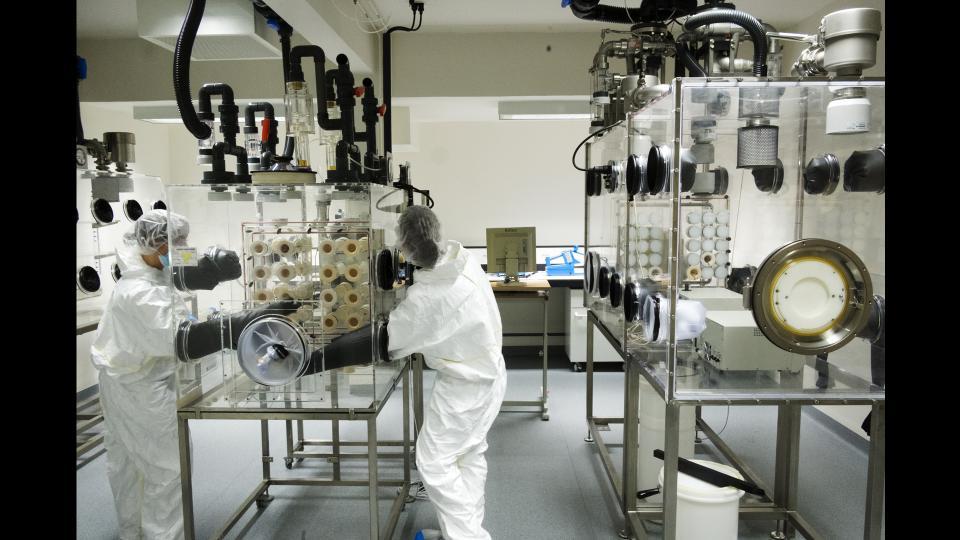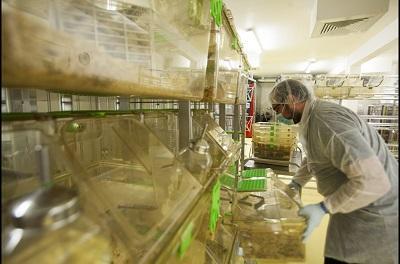The experimental platform for in vivo contamination PARISII
PARISII, the experimental platform for research on effects of radioactive substances following ingestion or inhalation, opened in July 2017. It encompasses the entire infrastructure, including housing rooms and various specialized laboratories, required to study the biological effects on internal radionuclide contamination. Located at IRSN's site in Fontenay-aux-Roses, it is a unique facility of its kind in Europe.
Background and purpose of the facility
IRSN's research teams carry out experimental and epidemiological research to understand the potential effects related to low doses of ionizing radiation in human and animal populations. Research conducted in the last twenty years or so at IRSN shows that the biological consequences, as well as the physiological responses, in individuals subject to chronic low-dose exposure, are different both in nature and in intensity to those of people subject to acute exposure.
Experimental research programs conducted at the IRSN aim to build up knowledge to better understand the mechanisms involved so to explain these effects. Experimental tools are developed with a view to having an integral vision of the consequences of chronic exposure on the key physiological functions of individuals and populations affected.

To pursue these research programs, the PARISII platform was created on the IRSN site in Fontenay-aux-Roses. This experimental platform includes housing rooms (rats and mice), as well as dedicated laboratories to perform biological tests. Short-, medium- and long-term contamination (up to 24 months) by different radionuclides (e.g. radioactive isotopes of uranium, cesium, strontium, etc..) at low (c. 100 mGy) to moderate (< 1Gy) doses can be done in the platform. Different exposure pathways can be studied, mainly by ingestion or inhalation.
The facility is also linked to other IRSN platforms, such as those used for research on external radiation (ALPHÉE, SARRP, etc.) or imaging (PATERSON). PARISII is also open for French and international scientific collaborations.
Technical platform
Animal house and specific laboratories
The platform covers a total surface of 1,450 m². It is composed of eight housing rooms, fully equipped with ventilated cages and the related support rooms (laundry, storage). It can house up to 2,800 rodents (1,300 rats and 1,500 mice). All the equipment needed for contamination via the three major pathways (respiratory, oral and percutaneous transfer), including an inhalation platform (four gloveboxes) equipped with "nose only" inhalation chambers is also available.
PARISII also has several laboratories for in vivo studies on the effects of contamination, including an animal behavior laboratory, in order to test learning abilities, memory, locomotion and anxiety of contaminated animals.
Analysis laboratories
PARISII has facilities for preparation and control of contaminated solutions (including drinking water) and for measurement of the radioactivity levels accumulated in the animals (organs, tissue, cells). All these facilities are encompassed in:
-
a laboratory for physical measurements applied to internal contamination (alpha, beta and gamma spectrometry),
-
a radiochemistry laboratory,
-
an electron microscopy laboratory.

Another two (Level 2 Biosafety) contained laboratories are used to study the effects of contamination on cell cultures. It also includes specific laboratories for testing biological samples collected in vivo, such as blood, urine and organ samples (biochemistry, molecular biology, cell biology, histology, physiology, and electrophysiology). Cold rooms are used to store specimens for later testing, and two rooms are used to store radioactive sources.
The field of expertise covered is broad; projects can decipher the responses of and effects on various systems: the renal, cardiovascular, hematopoietic, central nervous, reproductive, hepatic, bone and thyroid systems.
Last, the platform is equipped with a water treatment station (in the basement) that can be used to treat liquid effluent contaminated by radioactive particles, if needed.
Related research
The PARISII facility can be used for research on any subject related to understanding the biological effects of internal contamination:
-
Radionuclide biokinetics
-
Non-cancerous effects following chronic contamination or external exposure: adaptive renal and cardiovascular response, effects on the reproductive system and the cardiovascular system, analysis of rodent behavior
-
Cancerous effects following internal contamination
-
Multi-generational effects of chronic internal contamination (e.g. epigenetic and metabolomic responses)
-
Potential interactions between radiological and chemical co-contamination
-
Impact of nano- and micro-particles on the central nervous system (toxicology, location and speciation).
The Ethics Committee and the GSEA (Animal Research and Ethics Support Group)
In spite of recent advances in developing alternative methods, the use of animals in research remains necessary to study the biological effects at the scale of the whole organism and to understand the complex mechanisms involved. This is especially true in the case of radiotoxicology, where the objective is to demonstrate the potential and often subtle effects of radionuclide intake.
The use of animals for research purposes is strictly controlled in France, by national and European regulations, national guidelines and by the principles of ethical animal experimentation. The animals used are housed at the PARISII facility in conditions designed to ensure their welfare and maintain health standards. The experiments carried out by IRSN comply with the principle of the 3Rs:
-
reduce: reduce the number of animals used;
-
replace: use alternative methods whenever possible;
-
refine: improve procedures to minimize suffering and pain.

Back in 1998, IRSN set up a multidisciplinary, independent and impartial ethics committee, composed of IRSN personnel and external experts. All projects requiring animal testing are assessed and approved by this committee and must then be authorized by the French Ministry for Research. The in vivo facilities are regularly inspected by the Departmental Directorate for Public Health and Safety, under the aegis of the French Ministry for Agriculture.
In addition, teams carrying out experimental procedures at the PARISII facility receive support by the GSEA, whose main objective is to ensure that the animals are well treated within the framework of ethical and responsible use.
Characteristics
Animal house capacity: 1,300 rats, 1,500 mice
Radionuclides studied: radioactive isotopes of U, Sr, Cs, Co, Pb, 14 C, 3H, etc.
Test equipment:Flow cytometer, gene (RT-qPCR) and protein (Multiplex) expression analyzer, sperm analyzerScanning and transmission electron microscopeMass spectrometer (ICP-MS), (alpha, beta and gamma) detectors, X-ray diffraction
Special rooms:
2 rooms for cell cultures (Level 2 Biosafety)1 biochemistry room2 molecular biology roomsTest, microscopy, histology and electrophysiology rooms
